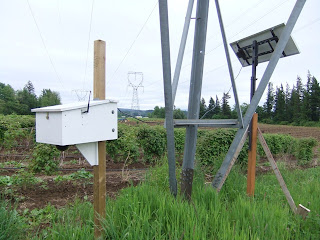 This has been a slow spring for raspberry pollination. It's been raining nearly every day for several weeks, or so we've heard. John and I made our visit to Corbett last Sunday because it was the only day all of last week and this week that rain was not predicted. We hoped for some sun, and got perhaps a hazy hour or two, but most of the day was overcast. Temperatures were in the low to mid 60s during our visit.
This has been a slow spring for raspberry pollination. It's been raining nearly every day for several weeks, or so we've heard. John and I made our visit to Corbett last Sunday because it was the only day all of last week and this week that rain was not predicted. We hoped for some sun, and got perhaps a hazy hour or two, but most of the day was overcast. Temperatures were in the low to mid 60s during our visit.The first photo is of black raspberry flowers. They are not very showy. Petals are small. This inflorescence had 6 flowers on it, more than most inflorescences. The flowers have many stamens wiht brown anther sacs in a circle around a cluster of white pistils in the center. I expect (though I didn't have time to observe) that most honey bees go after nectar from the side rather than from the top. That would limit their ability to move pollen from stamens to stigmas. Yet the flowers are getting pollinated. The flower in the middle is clearly developing a fruit.
This inflorescence gives a good indication of where we are in pollination. One flower with a developing fruit, one flower at the top right has lost it's petals and will probably show a developing fruit in a few days, two or three flowers are in full bloom with anthers in various stages of presenting pollen.
 Here's a view of several rows of black raspberry in bloom. Can you tell it's in bloom? From this distance you can just make out small clusters of flowers in the closest bushes, if you know that they are flowers.
Here's a view of several rows of black raspberry in bloom. Can you tell it's in bloom? From this distance you can just make out small clusters of flowers in the closest bushes, if you know that they are flowers.
Despite the poor weather bumble bees and honey bees were busy foraging all day on Sunday. Rosie commented that the bumble bee population on their farm seems to have been increasing in the last couple of years. There are no honey bee hives on the Sturm farm this year, but honey bees have been coming in from elsewhere. My guess is that the bumble bees and honey bees are responsible for most of the pollination on the farm this year. I saw a few tiny halictids on the berry flowers as well, but they were mostly taking nectar from the side of the flowers, so probably not doing much pollination. The O. aglaia have not been very active as far as I can tell - more on that later.

Compare the black raspberry with marion berry flowers. The petals are much larger and showier, and the flowers can be seen from a distance away on the shrubs (photo below). The blackberries bloom a little later than the raspberries, but they are in full bloom now, and getting multiple visits from bumble bees and honey bees. There is even an ant crawling around on the lowest marion berry flower in this close-up.
 Rosie put out a shelter with more of our Binderboard and O. aglaia next to the marion berries (scroll down to see photo). Something has been getting at the bees - maybe a humingbird? We covered the entrance to try to deter predators.
Rosie put out a shelter with more of our Binderboard and O. aglaia next to the marion berries (scroll down to see photo). Something has been getting at the bees - maybe a humingbird? We covered the entrance to try to deter predators.










